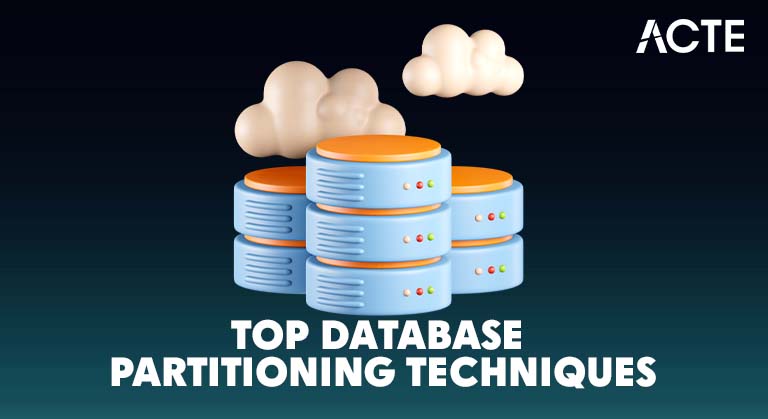
- What is Partitioning?
- Why Partition Data?
- Horizontal Partitioning
- Vertical Partitioning
- Range Partitioning
- List Partitioning
- Hash Partitioning
- Composite Partitioning
What is Partitioning?
Partitioning is a database optimization strategy that involves dividing a large table or index into smaller, more manageable pieces, while still being treated as a single object in SQL queries. This technique enhances performance and scalability by allowing queries to access only the relevant partitions instead of scanning the entire dataset. Common Database Partitioning Techniques include range partitioning, list partitioning, hash partitioning, and composite partitioning, each suited for specific data access patterns and business needs. For instance, SQL Server partitioning for performance is often used in environments with large transactional data volumes, enabling faster query response times and easier data maintenance a technique commonly covered in Database Developer Training programs. On the other hand, Oracle partitioning license is required when using Oracle’s advanced partitioning options, which offer powerful tools for managing and querying big data efficiently. Partitioning also helps streamline backups, archiving, and data purging tasks by operating on specific segments instead of full tables. When implemented correctly, partitioning not only reduces I/O operations but also improves concurrency and simplifies administration in enterprise databases. Whether you’re handling time-series data, geographically distributed information, or high-frequency transactions, partitioning is an essential technique in modern database design aimed at maintaining peak performance as data grows.
Do You Want to Learn More About Database? Get Info From Our Database Online Training Today!
Why Partition Data?
- Improved Query Performance: Partitioning allows queries to scan only the relevant portion of data, reducing read time. This is especially true in Delta Lake partition systems, where query engines skip over irrelevant files for faster access.
- Efficient Storage Management: Tools like AWS Glue partitions help in organizing data in data lakes by directories, enabling efficient storage handling and cost-effective data processing a strategy that complements relational concepts like those in Self-Join in SQL Explained tutorials.
- Enhanced Scalability: In-memory databases like Redis partitioning distribute data across multiple shards or nodes, ensuring better scalability as data grows.
Partitioning data is a crucial practice in modern data engineering and database management, especially when working with large-scale systems. By dividing data into segments based on specific criteria like date, region, or ID, you can significantly enhance performance, scalability, and data organization. Here’s why partitioning data matters:

- Simplified Maintenance: With PostgreSQL partitioning, managing large tables becomes easier. You can drop or archive partitions without affecting the entire dataset.
- High Availability and Load Balancing: Aurora partition features in AWS help distribute read and write workloads efficiently across replicas, increasing performance and resilience.
- Optimized Data Pipelines: Partitioning plays a critical role in big data ETL processes. In systems like Glue or Delta Lake, partitions ensure that jobs process only the necessary data, saving time and resources.
Horizontal Partitioning
Horizontal partitioning, also known as sharding, is a Database Partitioning Technique where rows of a table are divided into multiple smaller tables, each containing a subset of the data. Unlike vertical partitioning, which splits columns, horizontal partitioning maintains the same schema across partitions but distributes rows based on defined criteria, such as date ranges, regions, or customer IDs. This method is highly effective in managing large datasets, improving read and write performance by limiting the volume of data accessed during queries an approach often highlighted in an Overview of SQL Server Certification curriculum. In enterprise environments, SQL Server partitioning for performance is widely adopted, allowing large transactional tables to be horizontally partitioned for faster access and easier maintenance. Similarly, Oracle supports advanced horizontal partitioning capabilities, but users must consider the Oracle partitioning license, which is required to access features like interval, reference, and composite partitioning. Horizontal partitioning enhances scalability by distributing data loads and supports better concurrency by reducing contention on a single large table. It’s particularly beneficial in cloud and distributed systems where data needs to be split across multiple servers or storage nodes. Ultimately, horizontal partitioning is a strategic approach to data management, ensuring optimal performance, scalability, and maintainability of high-volume databases in modern applications.
Would You Like to Know More About Database? Sign Up For Our Database Online Training Now!
Vertical Partitioning
- Improved Query Efficiency: Queries that access only a few columns run faster since the database reads less data. This is especially useful in SQL Server partitioning for performance, where vertical partitioning can significantly cut down query time.
- Reduced Storage Overhead: Frequently accessed columns stored separately allow better compression and less redundant data storage, optimizing space usage principles often emphasized in Database Administration Fundamentals courses.
- Better Cache Performance: Smaller rows fit more efficiently into memory and cache, improving response times for high-volume applications.
Vertical partitioning is a Database Partitioning Technique where a table is split into smaller tables containing fewer columns, each focusing on a specific subset of data. This method is particularly effective when certain columns are accessed more frequently than others, enabling better performance and streamlined data management. By storing commonly used columns separately, vertical partitioning can reduce I/O, enhance query performance, and improve cache efficiency.

- Enhanced Security and Compliance: Sensitive data like PII can be stored in separate partitions, simplifying access control and data protection.
- Optimized Maintenance: Vertical partitions allow for focused indexing and updates, reducing the load on the full table.
- Oracle Support with Licensing: Advanced vertical partitioning features in Oracle may require an Oracle partitioning license, offering powerful tools to optimize large enterprise systems.
- Optimized Query Filtering: Queries targeting specific values (e.g., a particular region) can quickly access relevant partitions, reducing scan time and improving speed a key factor in SQL Server partitioning for performance.
- Simplified Data Management: Managing category-specific data (like customer types or product lines) becomes easier, as each list-based partition can be maintained separately.
- Improved Load Balancing: Distributing records by list values helps balance data volume across partitions, minimizing hotspots and enhancing system responsiveness an approach often evaluated in Data Lakes and Data Warehouses Comparison discussions.
- Targeted Indexing: List partitions allow for localized indexing strategies tailored to specific data groups, reducing index size and boosting efficiency.
- Ease of Archiving and Purging: Data can be archived or purged by partition, making lifecycle management more straightforward.
- Advanced Oracle Support: Oracle partitioning license enables powerful list partitioning features, making it a go-to choice for enterprises managing diverse, categorized datasets.
Range Partitioning
Range partitioning is a popular data organization method where rows are distributed into different partitions based on a range of values from a specific column, such as dates or numerical IDs. This approach simplifies data management and boosts performance by allowing systems to scan only the relevant data ranges instead of entire tables. It is particularly effective for time-series data, logs, and transaction records. In big data environments, Delta Lake partition leverages range partitioning to organize files efficiently, enabling faster reads and writes during large-scale analytics concepts that align with foundational principles covered in an Introduction to MySQL Databases course. Similarly, PostgreSQL partitioning supports native range partitioning to manage large datasets by breaking them down into more manageable chunks, improving both query performance and maintenance tasks. In-memory systems like Redis partitioning benefit indirectly by using range-based sharding strategies to distribute keys evenly across nodes. On cloud platforms, Aurora partition features can help split data across storage segments, improving replication and read performance. Tools like AWS Glue partitions also utilize range-based logic to optimize data processing in ETL jobs, ensuring only the necessary subsets of data are processed at runtime. Overall, range partitioning is a key technique that enhances scalability, simplifies querying, and supports efficient data lifecycle management across modern database and data lake architectures.
To Earn Your Database Certification, Gain Insights From Leading Blockchain Experts And Advance Your Career With ACTE’s Database Online Training Today!
List Partitioning
List partitioning is a Database Partitioning Technique where data is divided into partitions based on a predefined list of discrete values. Unlike range partitioning, which uses continuous value ranges, list partitioning groups rows with specific values for example, by country, region, or department. This method is ideal for datasets where certain categories are frequently accessed or managed independently. It enhances query efficiency and simplifies data maintenance.
Hash Partitioning
Hash partitioning is a data distribution method where a hash function is applied to a partition key, and the result determines which partition the data belongs to. Unlike range or list partitioning, which use logical or sequential grouping, hash partitioning ensures a more even and random distribution of data, making it highly effective for workloads with no obvious natural segmentation. In systems like Redis partitioning, hashing is a core mechanism for distributing keys evenly across nodes to ensure load balancing and high availability techniques that contrast with traditional RDBMS approaches often discussed in Differences Between PostgreSQL vs MySQL comparisons. Similarly, PostgreSQL partitioning supports hash-based methods to divide data into equal-sized partitions, enhancing parallel processing and reducing bottlenecks. Delta Lake partition implementations can combine hash with other partitioning strategies to improve performance during distributed query execution. On cloud platforms, Aurora partition and AWS Glue partitions may utilize hash logic to manage distributed data storage and ETL workloads efficiently, especially when working with massive, non-uniform datasets. Hash partitioning is particularly useful when query patterns are unpredictable or when aiming to avoid skewed data distribution, which can cause performance issues. By spreading data uniformly, hash partitioning supports scalability, improves concurrency, and ensures that storage and computational resources are used more effectively across large-scale data systems.
Preparing for a Database Job? Have a Look at Our Blog on Database Interview Questions and Answers To Ace Your Interview!
Composite Partitioning
Composite partitioning is an advanced data management technique that combines two or more partitioning strategies typically range, list, or hash to achieve greater flexibility and performance in handling large datasets. By layering partitioning methods, composite partitioning enables more refined data segmentation and optimized query execution. For example, a table might first be range-partitioned by date and then hash-partitioned within each range by user ID, allowing queries to efficiently target both temporal and distributed user data. In Delta Lake partition systems, composite partitioning helps organize massive datasets across cloud storage by combining date-based and key-based splits for high-speed analytics. PostgreSQL partitioning also supports composite strategies, allowing developers to tailor data distribution to complex business logic. While Redis partitioning primarily uses hash mechanisms, composite techniques can be simulated for advanced sharding logic in distributed environments concepts often explored in Database Administration Fundamentals modules. In Aurora partition setups, combining read-replica distribution with logical partitioning improves high availability and scalability. Likewise, AWS Glue partitions often process composite-partitioned data for efficient ETL operations, enabling jobs to scan only the most relevant subsets of data. Overall, composite partitioning offers a highly customizable and scalable approach to data architecture, ensuring optimal performance across querying, storage, and processing tasks in modern data ecosystems.


